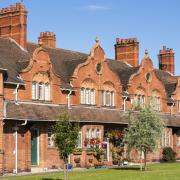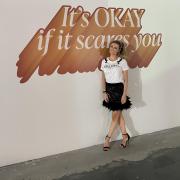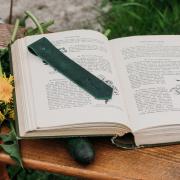Meander through the streets of Macclesfield and its surroundings and the imprint of the town’s silk-producing legacy is all around. Now significant threads are being picked up to ensure this rich heritage has new life

The Silk Museum and Paradise Mill
For more than four decades, the handlooms at an old Cheshire silk works stood silent.
But listen carefully, and sometimes the click and rattle, with the whoosh of the weave can be detected again at Paradise Mill in Macclesfield. Intricate looms are being lovingly restored and a new piece of silk has been woven for the first time in 40 years.
It all marks a new chapter for the mill, which is unique because it has the largest collection of silk Jacquard handlooms in their original setting in Europe. They stand just as the workers left them and have been listed by Historic England to conserve them.
The mill was first mothballed in 1981 when commercial production ceased after more than a hundred years. It became part of the Silk Museum and was open to visitors until the pandemic closed its doors again.
Since then, museum staff and trustees have been working to secure its future. The building, built in 1862, has had a new roof, windows, and a lift during its restoration, thanks to a Government Covid recovery grant and investment by the owners, Allmand-Smith Ltd. It reopened for visitor tours in February.

Now the bricks and mortar has been attended to, Silk Museum director Emma Anderson is very clear this is a place with a past to tell and also a future to look forward to.
‘The mill re-opened with a huge sigh of relief. It is the start of a process of getting the mill back to life and being this amazing heritage treasure for the town,' she says.
‘The looms tell remarkable stories of silk production in Macclesfield. They must be kept in working order so visitors experience the incredible sights and sounds of these machines. We need to revive and expand the technical knowledge of how to operate and care for them so they can continue to inspire future generations of weavers for years to come.’
The Silk Museum incorporates Paradise Mill in Park Green and the former Macclesfield School of Art next door, which houses the artefacts.
Last year silk weaving was added to the official list of heritage crafts considered to be endangered, but Emma is determined it will not join cricket-ball making or gold beating on the extinct list. One of the grants she has helped to secure is from the Radcliffe Trust to develop a plan to conserve the looms and fund creative placements for emerging craftspeople.

Weavers Bea Uprichard and Ruth Ferris, textile design students at Manchester Metropolitan University, are the first to weave a new silk using traditional techniques. Bea says they researched patterns but had to work out how to make the silk themselves.
‘There used to be word-of-mouth apprenticeships that lasted seven years. There was nothing written, so we had to work back from examples.’
It took Bea and Ruth just six weeks to master the complicated setup of the loom and produce their first design.
In the early days of silk making, young boys would sit on the top of looms making sure threads were in the correct place to make the pattern but in 1801 Joseph Marie Jacquard revolutionised the process with his punch cards. Each row of punched holes and spaces on the card represented a line of textile pattern. Hundreds of punch cards would then be laced together to create the whole weave, telling the loom when to raise the warp. It was a binary system that, amazingly, became the precursor to modern computing, inspiring the likes of Charles Babbage and Ada Lovelace.
Bea and Ruth recreated 192 punch cards in six days and laced them up in the right order.

‘We installed the set onto the loom and wove our first few rows of the pattern. It was magical. We then took it in turns to weave for two full days until we had about a metre of fabric – enough to cut off the loom,’ says Bea.
Ruth says: ‘The design is being shown in the mill, so we didn’t want it to be out of place, but it was important that it was our design too.’
Their work is on show on a loom tour guides use to demonstrate to visitors how the Jacquard method works. Tina Russell-Cruise, is one of the guides bringing the story of the mill alive. She tells of accidents, strikes, exploitation of children, of ‘women’s work’ and ‘men’s work’, and of the craftsmanship and dedication to detail of the weavers who were producing luxury silk goods for retailers such as Liberty in London.
‘There is a saying that the weaver needs the foot of a bear, the eye of a hawk and the hand of a lady,’ she says.
Her fellow tour guides, Daniel Hearn and Trish Halloran, alongside weaver Rebecca Faragher may well agree. They are painstakingly restoring two of the 400-hook handlooms. Daniel says: ‘This restoration involves considerable effort, especially the building of a new Jacquard harness. Establishing a strong foundation in acquiring these skills means we are taking the first critical steps in ensuring this niche Jacquard handloom weaving remains operational.’

The Silk Museum next door has also been revamped, with a shop selling quality silk goods and pocket-money souvenirs. There are plans for a destination café to replace its current one and work is continuing to collect and tell the stories of silk production.
Visitors can learn about links with Ancient Eqypt, how a stuffed panda admired by Hitler came to Macclesfield, and how silk weaving was designated as a reserved occupation during the war – it produced silk maps (lighter and more waterproof than paper) for soldiers entering France, and silk for parachutes.
Referencing the building’s history as the School of Art, Emma and her team have set up a new School of Art for children and adults, so learning can continue. At Museum Tots, on Thursday mornings during term-time, youngsters can handle objects, learn about machinery, and join in singing and craft activities. The History Hunters meet on Thursdays too; they are a group of volunteers searching through archives finding more stories and documenting the collection, and on Friday mornings there's Have A Dabble, an adult arts and crafts group experimenting with different art techniques each week.

Emma says: ‘We are all passionate about the museum and for it to be at the heart of the community. We are passionate it is not just a step back in time. We have a long priority list of what we want to achieve, and we keep ticking it off because staff and volunteers are really strong, focused and determined.’
The Silk Museum is open Wednesday to Saturday from 10am until 4pm. Entry is free but donations are appreciated. It is advisable to pre-book a tour of Paradise Mill, which run daily at 11am, 12.30pm and 2.30pm. The tour is £11.50 per adult, £10.50 concessions and under-16s go free.
thesilkmuseum.co.uk

The Tailoring Academy
A former silk mill in Macclesfield now has a new lease of life housing The Tailoring Academy. The independent provider is approved by the British Accreditation Council for independent further and higher education and teaches students bespoke tailoring at the highest level in the UK. It was set up five years ago by master tailor Brita Hirsch who relocated to live in Silk Town and now has 40 students a year, both inhouse and online.
She is passionate about passing on the full set of coveted heritage techniques, helping to close a skills gap and opening opportunities for the next generation of craftspeople.
‘Common practice on Savile Row today is to train an apprentice in a specialism, to be a trouser maker, cutter or finisher – and become part of a production chain,’ said Brita.
‘This is beneficial for the employer of course but does not enable younger tailors to become entrepreneurs themselves. The wider issue is that the skills are lost as a consequence.’
The full-time Level 5 Diploma course is an Ofqual-regulated qualification and the new international programme is approved by the UK Fashion and Textiles Association.
Brita runs the academy alongside her tailoring business. She has developed her own fabric for suits, called The Great Northern Cloth, spun from wool sourced from Merino sheep and woven in West Yorkshire and with some lined with silk. Each suit for male or female clients, can take up to 80 hours to make
In the past, Brita has made tails for Pavarotti, which she describes as a ‘truly terrifying’ and ‘most rewarding’ experience, and costumes for Phantom Of The Opera. Now clients travel from the Hollywood Hills to the Cheshire countryside for a suit that is a true British original.
tailoringacademy.co.uk
hirschtailoring.com

Adamley Textiles
In the foothills of the Pennines, in the village of Langley, two miles out of Macclesfield is Adamley Textiles. The company produces luxury printed silk fabric and accessories.
Here the heritage of the past is interwoven with the contemporary designs and methods of today. The business has built a library at the mill to archive patterns from English and French mills, some from as far back as the 18th century, which now inspire new designs.
'Clients are invited to browse the archive to take inspiration for their next scarf design. Our team of designers can bring a silk creation to life – whether that’s simply to perfect a client’s own artwork to get it ready for print, or to re-imagine and modernise any of our historical designs,' says Tro Manoukian, chief executive officer.
Having been specialist silk printers for more than 300 years, Adamley today specialises in traditional screen-printed silk and digital print, producing the most complex of designs. There are six dedicated screen-printing tables and dye are produced in-house to match a client’s colour palettes. Screen printing on silk is a fastidious process involving hand printing colours, layer by layer, screen after screen, with precision, drawing on the expertise of staff.
Adamley has invested in sustainability by installing a new solar system to reduce its carbon footprint, and re-insulating the printshop roof, cutting heat loss by 35 per cent. Its location by the River Bollin, means Adamley can source its water from its very own reservoir.
adamley.co.uk

R A Smart
The commercial production of Jacquard Weaving is alive and growing in Macclesfield using the latest in technology. R A Smart is a bespoke textile manufacturer creating contemporary designs and accurate historic reproductions to order.
'We have modern high speed dedicated looms capable of producing the most intricate of Jacquard Woven designs,' says Ronald Smart, founder and company director.
'We have seen sales double for our woven designs in 2022, and up 40 per cent in 2023'
There are have four high-speed looms producing woven combinations of silk, wool, cotton and linen.
One of the most successful lines is silk ties, with more than 80 per cent exported to Japan, United States and Europe.
The company is also heavily invested in the expertise of staff who have built up years of knowledge of colour, design, and weave since the business was founded in 1970.
Working conditions are entirely different to the traditional mill days of old, with R A Smart investing in high-tech air conditioning, keeping staff safe and enhancing the quality of the fabric. As a further contribution to sustainability, in 2023 the company installed 473 solar panels generating 36 per cent of energy requirements and reducing CO2 emissions by 100 tons per year.
As well as Jacquard weaving, R A Smart offers custom-printed wallpaper, digital textile printing, and screen printing.
rasmart.co.uk



























